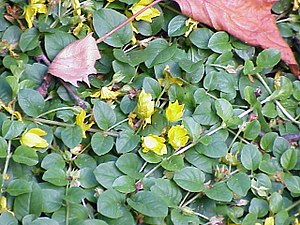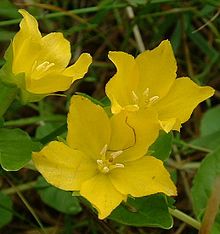Pennywort
| Pennywort | ||||||||||||
|---|---|---|---|---|---|---|---|---|---|---|---|---|

Pennywort ( Lysimachia nummularia ) |
||||||||||||
| Systematics | ||||||||||||
|
||||||||||||
| Scientific name | ||||||||||||
| Lysimachia nummularia | ||||||||||||
| L. |
The moneywort ( Lysimachia nummularia ), also Münzkraut or penny-Gilbweiderich called, is a plant of the genus Gilbweiderich ( Lysimachia ) in the subfamily of Myrsinengewächse (Myrsinoideae) within the family of Primrose (Primulaceae).
Surname
The generic name Lysimachia refers to the ancient general Lysimachos , whom Alexander the Great used as one of the diadochi . According to legend, Lysimachus was the first to discover this genus of plants.
The species name nummularia (Latin nummus "coin") and the German name (from Old High German pfenning ) allude to the similarity of the leaves with small coins ( pfennigs ).
Distribution and occurrence
The pennywort is a species that occurs in the temperate areas of Europe and Asia. Today it is also offered as an ornamental plant and has thus found worldwide distribution. In some locations it is also overgrown and is therefore considered a neophyte in some regions outside Eurasia .
The pennywort thrives on fresh or moist, nutrient-rich and base-rich soils. It's a clay pointer. In Central Europe it is a weak character species of the Agropyro-Rumicion association, but also occurs in gappy societies of the Molinio-Arrhenatheretea class or the Alliarion or Alno-Ulmion associations.
In the Allgäu Alps in Bavaria between Höflealpe and Hölloch it rises up to 1300 m above sea level.
description
Pfennigkraut is an evergreen, creeping, perennial herb that grows like a lawn on suitable soil. It reaches a height of only 5 centimeters. The glandular dotted compared continuously to the stems disposed leaves consist of a short petiole and a rounded or elliptical leaf blade with a blunt tip. The length of the leaves varies between 1.5 and 2.5 centimeters, the width is 1.5 to 2 centimeters.
The five-fold flowers, up to 30 millimeters long, stalked and bright yellow, arise individually from the leaf axils. They have a double perianth . The hairless, heart-shaped calyx tips are about 3 to 5 millimeters long. The corolla lobes develop a length up to about 15 millimeters. Although the flowers are pollinated by insects, the flowers are often sterile and hardly develop any fruit set. The seeds of the rarely occurring capsule fruits are spread over water and people.
The plant species spreads predominantly vegetatively. It forms up to 50 centimeters long, above-ground creeping runners that root at the nodes and separate from the mother plant. This so-called blastochoria as the predominant form of spread is rare in the plant kingdom. The blastochore spreading is used by most plants - for example wild strawberries - as a supplementary spreading strategy.
The species has chromosome number 2n = 32, 36, 43 or 45.
use
Use as an ornamental plant
In the garden, it is often planted on the banks of ponds, as it is an excellent ground cover plant.
In addition to the green-leaved, there is also a variety with yellowish leaves, the yellow-leaved pennywort ( Lysimachia nummularia 'Aurea').
Use in herbal medicine

In the 15th century the plant was also called "leech herb" and was used as a wound healing agent . Hieronymus Brunschwig took this indication into his small distilling book for his "Egilkraut", which he also called "centum morbia", which was published in 1500 . He added “ rur ” to the indication in the sense of bloody diarrhea. Among the fathers of botany , it was Hieronymus Bock first who in 1539 described the "leech herb" - "Serpentaria minor" - "Hirundinaria" - "Penny herb" - "Herba nummularia" in his herbal book. He also characterized the plant as a wound healing agent, and also described its use for lung diseases. In his herbal book published in 1543, Leonhart Fuchs adopted Bock's explanations and added a true-to-life illustration of the plant.
In Central Europe, pennywort no longer plays a role in herbal medicine . In Eastern Europe it is still used occasionally against diarrhea , rheumatism , bleeding and consumption .
Use in the aquarium hobby
Pennywort can also be cultivated in unheated aquariums . It thrives optimally up to 20 ° C. The stem plant is permanently suitable for submerged cultivation up to 25 degrees . The growth is then vertical with a few branched stems. Lysimachia nummularia has no special requirements for water values . Due to its rapid growth, also (as a marsh plant) over water, it is ideally suited to extract nutrients from the water.
Individual evidence
- ↑ a b c d Erich Oberdorfer : Plant-sociological excursion flora for Germany and neighboring areas . 8th edition. Stuttgart, Verlag Eugen Ulmer, 2001. ISBN 3-8001-3131-5 , page 742.
- ↑ Erhard Dörr, Wolfgang Lippert : Flora of the Allgäu and its surroundings. Volume 2, IHW, Eching 2004, ISBN 3-930167-61-1 , p. 323.
- ↑ a b Eckehart J. Jäger, Friedrich Ebel, Peter Hanelt, Gerd K. Müller (Eds.): Rothmaler Exkursionsflora von Deutschland. Volume 5: Herbaceous ornamental and useful plants . Spektrum Akademischer Verlag, Berlin Heidelberg 2008, pages 614 f., ISBN 978-3-8274-0918-8
- ^ Rothmaler: Exkursionsflora von Deutschland , Spektrum Akademischer Verlag Heidelberg, Berlin, 20th edition 2011, page 281. ISBN 978-3-8274-1606-3
- ↑ Lysimachia nummularia 'Aurea' at PlantFinder.
- ↑ Manuscript, Alsace, 1st quarter of the 15th century (Frankfurt Ms. Germ. Qu 17, sheet 343rb): "Egelkrut waſſer whom one ſprichet gemūte [?] Iſt well drunk so one gevallen iſt" (digitized version )
- ↑ Hieronymus Brunschwig. Small distilling book. Strasbourg 1500, sheet 46r (digitized version )
- ↑ Hieronymus Bock. Herbal Book , Strasbourg 1539, Part II, Chapter 88 (digitized version)
- ↑ Leonhart Fuchs. Herbal Book . Basel 1543, chapter 152 (digitized version)
- ↑ Christel Kasselmann : aquarium plants. Ulmer Verlag, Stuttgart 1995; 2nd, revised and expanded edition 1999, ISBN 3-8001-7454-5 , p. 356.
literature
- Angelika Lüttig and Juliane Kasten: Rosehip & Co - Blossoms, fruits and spread of European plants. Fauna Verlag, Nottuln 2003, ISBN 3-935980-90-6
Web links
- Pennywort. In: FloraWeb.de.
- Pennywort . In: BiolFlor, the database of biological-ecological characteristics of the flora of Germany.
- Lysimachia nummularia L. In: Info Flora , the national data and information center for Swiss flora . Retrieved January 20, 2016.
- Thomas Meyer: Yellow loosestrife data sheet with identification key and photos at Flora-de: Flora von Deutschland (old name of the website: Flowers in Swabia )
- Lysimachia nummularia as an aquarium plant at www.flowgrow.de
- Lysimachia nummularia 'Aurea' as an aquarium plant at www.flowgrow.de


